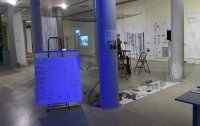The “Reggio Approach” to 0-99 Education: A Deep Exploration of Continuity
Keynote speeches at educational conferences these days often identify that change is underfoot in education and that we must embrace different learning models. Most don't say how to set these changes in motion. So I got my hopes up when Carla Rinaldi was announced as the keynote speaker at the Winter Institute in Reggio Emilia, Italy this past February.
Rinaldi is the President of the Foundation "Reggio Children - Loris Malaguzzi Centre" (LMIC) in Reggio Emilia, Italy, and her keynote didn't disappoint.
Now, an hour-long keynote that explores "continuity" and how it applies to learning and education may not sound interesting, but many years ago I learned to never underestimate Rinaldi's work. This was her lead-in:
As for the rest of Rinaldi's keynote, she eloquently foreshadowed the layers of the "Reggio Approach" that would unfurl for attendees over the week. Below are some snips from Rinaldi's brilliant speech to highlight two key elements from the Reggio system that I want to share with you.
People and Spaces: The Art of Collaboration
So what's different about the "Reggio Approach?"
A lot.
Each classroom we viewed in Reggio has roughly 15 students and two adult teachers. Yes, you read that correctly: two adult mentors for every 15 students. This investment alone shows the intense dedication to early childhood education in the Reggio Approach. However, putting two people in the room is not enough. Teachers I interviewed also have roughly 90 minutes of collaborative time built into every school day. That, as you might imagine, was also shocking to many conference attendees.
Collaborative elements run far deeper, though, with the help of two other key people and an artists' studio to promote deeper learning.
The "Atelierista" is a learning specialist in Reggio schools, an artist in residence of sorts, who works with teachers and students focusing on art and creativity. Writing, drawing and making things are primary threads to help students explore their voice and thoughts. This Atelierista works with teachers in classrooms and in a dedicated space called an "Atelier," essentially an educational art studio within the school building.
The "Pedagogista" is a learning theorist who helps teachers explore the thinking of children. This person works closely with teachers and the Atelierista to explore rich inquiry-based threads and learning projects, and to collaborate on best practices. The Pedagogista also helps teachers explore the continuity in each lesson, possibly to build projects over multiple years.
Locale and Resources: It's the Mission That Matters
To see all this collaborative approach in action, conference attendees were divided into groups and sent out to visit one Reggio school each day. Schools were chosen intentionally, so I gathered, to show that locale and resources need not hinder sound pedagogy.
One school in each tour was a flagship of modern design, and ripe with resources and materials. Every surface had a sheen, sporting inviting color palettes and rich arrays of materials to help students build and explore. The second school was set in a more impoverished area in Reggio, occupying a clean yet run-down building with limited facilities and resources. The third school again featured an older building, but this one was bursting at the seams with learning materials.
The diversity in the schools' facilities and resources was an essential part of the exploration. As different as these places were in appearance, the educational roles were the same in their adherence to the educational structure and inquiry-based approach to children's learning described above. I saw students and adults working together to improve practice and support each other.
Up Next
In Part II of this journey to the Reggio Emilia Winter Institute, we'll take a look at the mission Carla Rinaldi spelled out in her keynote to redefine schools as community learning centers.
